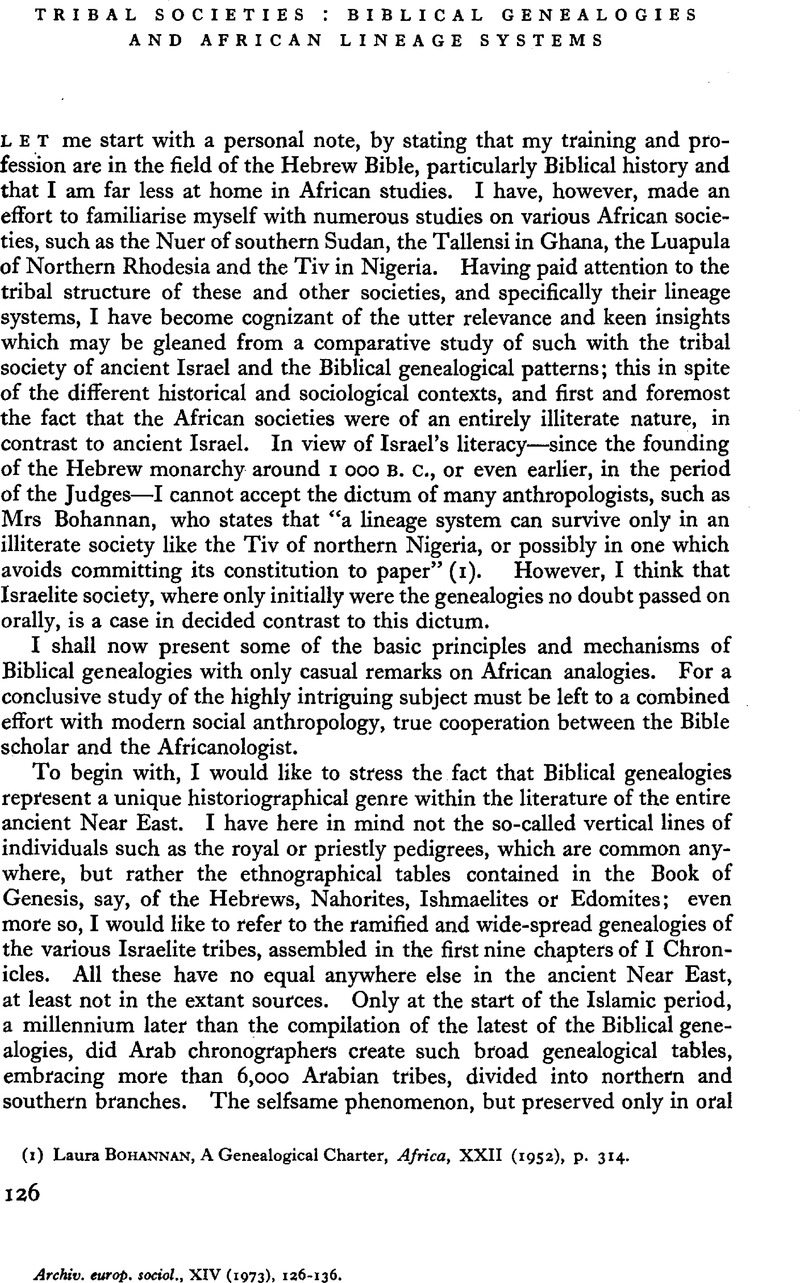Article contents
Tribal Societies: Biblical Genealogies and African Lineage Systems
Published online by Cambridge University Press: 28 July 2009
Abstract

- Type
- Notes Critiques
- Information
- European Journal of Sociology / Archives Européennes de Sociologie , Volume 14 , Issue 1 , June 1973 , pp. 126 - 136
- Copyright
- Copyright © Archives Européenes de Sociology 1973
References
(1) Bohannan, Laura, A Genealogical Charter, Africa, XXII (1952), p. 314Google Scholar.
(2) Cf. Malamat, A., King Lists of the Old Babylonian Period and Biblical Genealogies, Journal of the American Oriental Society, LXXXVIII (1968), p. 173n. 29Google Scholar.
(3) Evans-Pritchard, E. E., The Nuer2 (Oxford, Clarendon Press, 1940), p. 242Google Scholar.
(4) Malamat, , op. cit. 163–173Google Scholar.
(5) Cf. Galling, K., Erwägungen zum Stelenheiligtura von Hazor, Zeitschrift des deutschen Palästina-Vereins, LXXV (1959), 1–13Google Scholar, and most recently Graesser, C. F., Standing Stones in Ancient Palestine, The Biblical Archaeologist, XXXV (1972), 34–63Google Scholar.
(6) Evans-Pritchard, , op. cit. p. 199Google Scholar.
* This paper was first given as a lecture at the Jerusalem Congress on Black Africa and the Bible, 27 April 1972.
(7) Cf. Gluckman, Max, Politics, Law and Ritual in Tribal Society (Chicago 1965), p. 274Google Scholar.
(8) See both aforementioned authors, ibid.
(9) As for Africa, see in addition to the aforementioned authors recently Boston, J. S., Oral Tradition and the History of Igala, Journal of African History, X (1969), 29–43CrossRefGoogle Scholar, and concerning the Biblical analogies our remarks in Journal of the American Oriental Society, op. cit. pp. 170 sqq. and note 22 for further bibliography. For the universal phenomenon of sometimes telescoping genealogies and at other times artificially expanding them, see now also Henige, D.P., Oral Tradition and Chronology, Journal of African History, XII (1971), 371–389CrossRefGoogle Scholar.
(10) Cf. Cunnison, I., History and Genealogies in a Conquest State, American Anthropologist, LIX (1957). P. 27Google Scholar.
(11) Vansina, J., Oral Tradition: a study in historical methodology (London 1965), p. 153Google Scholar.
(12) Jones, G. I., Time and Oral Tradition with Special Reference to Eastern Nigeria, Journal of African History, VI (1965), p. 160Google Scholar, and for an allusion to Biblical genealogies cf. Albright, W. F., New Horizons in Biblical Research (London 1966), p. 11n. 1Google Scholar. Both studies mentioned in passing now also by Culley, R. C., Oral Tradition and Histopanding ricity, in Wevers, J. W. and Redford, D. B. (eds), Studies on the Ancient Palestinian World (Toronto 1972), p. 108Google Scholar.
- 11
- Cited by




